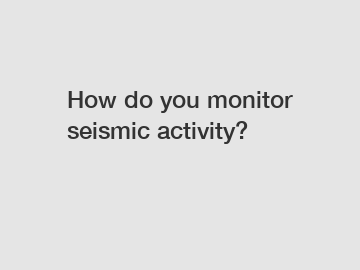How do you monitor seismic activity?
**Monitoring Seismic Activity**.
Seismic activity refers to the occurrence of earthquakes and other Earth vibrations. Monitoring seismic activity is crucial for predicting and preparing for potential natural disasters. Here is a step-by-step guide on how to monitor seismic activity effectively.
**1. Install Seismometers**.

The first step in monitoring seismic activity is to install seismometers. Seismometers are sensors that measure ground motion caused by earthquakes. They are usually placed in various locations to provide data on seismic events.
**2. Collect Data**.
Once the seismometers are installed, the next step is to collect data. The data collected by seismometers is transmitted to a central location where it is processed and analyzed. This data can include the magnitude, location, and depth of seismic events.
**3. Analyze Data**.
After collecting the data, the next step is to analyze it. This involves identifying patterns, trends, and anomalies in the seismic activity. By analyzing the data, seismologists can predict future seismic events and assess the level of risk in a particular area.
See also:Quartz Flexible Accelerometer: Advancing Precision Measurement and Monitoring
Spherical vs. Aspheric Lenses: A Clear Perspective
What is the difference between chromatic and achromatic lens?
The Science Behind Engine Test Benches: Unlocking Performance and Efficiency
Know the Features of the Multihead Weigher?
What is the passive seismic method?
**4. Use Seismic Network**.
To monitor seismic activity comprehensively, it is important to use a seismic network. A seismic network consists of multiple seismometers that are interconnected to provide real-time data on seismic events. This network can cover a large geographical area and enable early warning systems.
**5. Develop Early Warning Systems**.
One of the key purposes of monitoring seismic activity is to develop early warning systems. By using the data collected from seismometers and seismic networks, early warning systems can be implemented to alert people of an impending earthquake. These systems can save lives and reduce the impact of a seismic event.
**6. Collaborate with International Organizations**.
Monitoring seismic activity is a global effort, and it is important to collaborate with international organizations. By sharing data and resources with other countries, we can improve our ability to monitor and respond to seismic events worldwide.
In conclusion, monitoring seismic activity is a complex process that involves installing seismometers, collecting and analyzing data, using a seismic network, developing early warning systems, and collaborating with international organizations. By following these steps, we can better understand and prepare for seismic events.
If you are looking for more details, kindly visit Smartsolo Seismic Node Instruments, Dense Linear Seismic Arrays, Data Harvesting Rack of SmartSolo.
See also:Unleashing the Potential of 3D Seismic Exploration.
Stay Prepared for Earthquakes with Seismic Monitor
Unlock the Power of Smartsolo Nodes: Your Guide to Optimal Performance
Revolutionizing Seismology: Are 3 Component Geophones game-changers?
Unlocking Success: Seismic Crew Consultants Top Tips
What are the benefits of using short-period seismic nodes for monitoring earthquakes?
How Smart Seismic Sensor 1c Works









